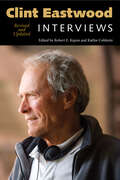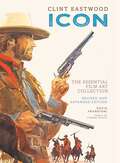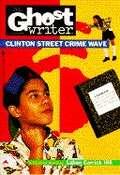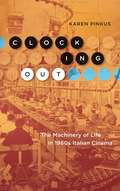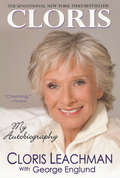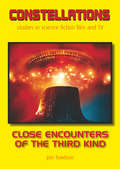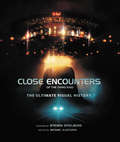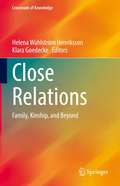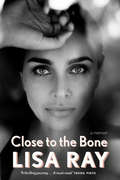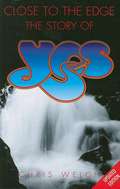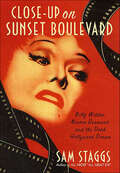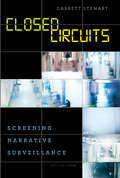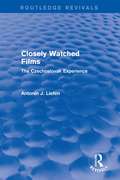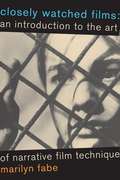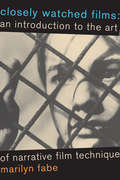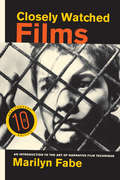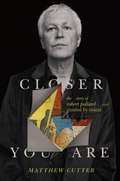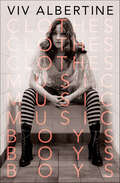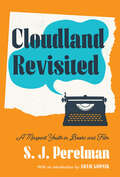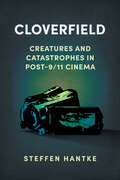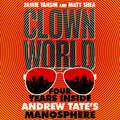- Table View
- List View
Clint Eastwood: Biografía
by Patrick McGilliganDel spaghetti western al cine de autor. La primera gran biografía del polifacético cineasta integral norteamericano. Aunque es uno de los rostros más conocidos de nuestra época, Clint Eastwood nunca se ha desprendido de una cierta aura de misterio, sobre todo en lo que a su pasado se refiere. Ahora, Patrick McGilligan, uno de los más respetados biógrafos del mundo del cine, nos ofrece un retrato de cuerpo entero del gran cineasta, un retrato donde por primera vez se descubre al hombre que hay tras la máscara cinematográfica. A través de documentos, manuscritos inéditos y archivos, entrevistas con amigos, familiares y socios que nunca antes habían hablado, el autor nos propone un exhaustivo viaje biográfico a través de los claroscuros de una vida intensa, febril y en algunos momentos inquietantes. En este libro ameno y riguroso a un tiempo, asistimos a la lenta metamorfosis de un joven actor de películas de acción que ha acabadopor convertirse en uno de los cineastas más premiados y admirados de nuestro tiempo. Y por supuesto, su vida íntima queda también reflejada en estas páginas, sobre todo sus atormentadas relaciones sentimentales y su recurrente paternidad ilegítima. Estamos, en definitiva, ante una de las mejores biografías que se han escrito en los últimos tiempos, un libro iluminador, valiente y polémico. Reseña:«La mejor y más admirable contribución a la clintología.»Financial Times
Clint Eastwood: Interviews, Revised and Updated (Conversations with Filmmakers Series)
by Robert E. KapsisClint Eastwood (b. 1930) is the only popular American dramatic star to have shaped his own career almost entirely through films of his own producing, frequently under his own direction; no other dramatic star has directed himself so often. He is also one of the most prolific active directors, with thirty-three features to his credit since 1971. As a star, he is often recalled primarily for two early roles—the “Man with No Name” of three European-made Westerns, and the uncompromising cop “Dirty” Harry Callahan. But on his own as a director, Eastwood has steered a remarkable course. A film industry insider who works through the established Hollywood system and respects its traditions, he remains an outsider by steadfastly refusing to heed cultural and aesthetic trends in film production and film style. His films as director have examined an eclectic variety of themes, ranging from the artist's life to the nature of heroism, while frequently calling into question the ethos of masculinity and his own star image. Yet they have remained accessible to a popular audience worldwide. With two Best Director and two Best Picture Oscars to his credit, Eastwood now ranks among the most highly honored living filmmakers. These interviews range over the more than four decades of Eastwood's directorial career, with an emphasis on practical filmmaking issues and his philosophy as a filmmaker. Nearly a third are from European sources—several appearing here in English for the first time.
Clint Eastwood: The Essential Film Art Collection
by Insight EditionsFeaturing rare, outstanding additional content, Clint Eastwood: Icon is the definitive collection of film art and material representing Clint Eastwood&’s legendary career as seen through the original iconic artwork.Clint Eastwood is a nameless vigilante, a vengeful detective, a bare-knuckle boxer, a Secret Service agent, and countless other definitive screen archetypes now embedded in our shared pop-culture consciousness. However you define him, Clint Eastwood has a powerful and extremely recognizable image that exists as something beyond the narratives of his films. Featuring a wealth of additional content, this new edition of Clint Eastwood: Icon presents an unprecedented collection of film art and rare material surrounding the legendary actor. This comprehensive trove gathers together poster art, lobby cards, standees, Italian Spaghetti Western Premier posters, studio ads, and esoteric film memorabilia from around the world. From his early roles as the nameless gunslinger in Sergio Leone&’s spaghetti Westerns, to the vigilante films of the 1970s and 1980s, through his directorial roles and latest releases, Clint Eastwood: Icon captures the powerful presence that turned Eastwood into the definitive American hero.
Clinton Street Crime Wave
by Laban C. HillHector and Alex discover that someone has been breaking into Phil Reiner's workshop, and wonder if it could be the same thief who has been stealing food from the Fernandez family store.
Clocking Out: The Machinery of Life in 1960s Italian Cinema
by Karen PinkusAn original reflection on Italy&’s postwar boom considers potentials for resistance in today&’s neoliberal (dis)order What can 1960s Italian cinema teach us about how to live and work today? Clocking Out challenges readers to think about labor, cinema, and machines as they are intertwined in complex ways in Italian cinema of the early &’60s. Drawing on critical theory and archival research, this book asks what kinds of fractures we might exploit for living otherwise, for resisting traditional narratives, and for anticapitalism. Italy in the 1960s was a place where the mass-producing factory was the primary mode of understanding what it meant to work, but it was also a time when things might have gone another way. This thinking and living differently appears in the cracks, lapses, or moments of film. Clocking Out is organized into scenes from an obscure 1962 Italian comedy (Renzo e Luciana, from Boccaccio 70). Reconsidering the origins of paradigms such as clocking in and out, &“society is a factory,&” and the gendered division of labor, Karen Pinkus challenges readers to think through cinema, enabling us to see gaps and breakdowns in the postwar order. She focuses on the Olivetti typewriter company and a little-known film from an Italian anthology movie, thinking with cinema about the power of the Autonomia movement, the refusal to work, and the questions of wages, paternalism, and sexual difference. Alternating microscopic attention to details and zooming outward, Pinkus examines rituals of production, automation, repetition, and fractures in a narrative of labor that begins in the 1960s and extends to the present—the age of the precariat, right-wing resentment, and nostalgia for an order that was probably never was.
Cloris: My Autobiography
by Cloris LeachmanShe received two Emmy Awards as the irrepressible Phyllis on The Mary Tyler Moor Show. . .she won an Oscar for her supporting role as a frustrated housewife in The Last Picture Show. . .she delighted audiences with her deliciously villainous turns as Frau Blucher in Young Frankenstein and Nurse Diesel in High Anxiety. . .and she earned even more award nominations playing a hard-drinking grandmother in Spanglish.Now, for the first time, the incomparable Cloris Leachman reflects on her amazing life and illustrious career. . .From her hometown in Des Moines, Iowa, (where she first saw Katharine Hepburn perform on stage, never imagining they would one day do Shakespeare together) to the bright lights of Broadway and the television studios of L.A., Cloris's journey has been filled with laughter and tears, marriage and motherhood, tragedy and triumph. Along the way, she shares wonderfully revealing anecdotes about Marlon Brando, Meryl Streep, Dianne Keaton, Sissy Spacek, Paul Newman, Steve McQueen, the Kennedy family, and many more. Funny, frank, brilliant, and altogether human, this is the real Cloris Leachman as you've never seen her before.Sparkling praise for Cloris!"Funny, gimlet-eyed and unpretentious--someone get this woman a talk show." --Kirkus Reviews"She lives what she preaches." --Library Journal
Close Encounters of the Third Kind
by Jon TowlsonFor many, Close Encounters of the Third Kind (CE3K) is not so much a movie as a religious experience. On its release in 1977, CE3K virtually redefined the science fiction film, shifting it away from spaceships, laser guns, and bug-eyed monsters into a modified form of science fiction that John Wyndham once called 'logical fantasy'. What would it be like if extra-terrestrials made contact with people on Earth? How would it feel? Like 2001: A Space Odyssey (1968), Steven Spielberg's primary inspiration, CE3K is concerned with mankind's evolution towards the stars, towards a state of transcendence. But Spielberg's vision hinges not so much on cool scientific intellect being the key to our next stage of evolution, as on the necessary development of emotional intelligence. To that end, we must regain our childlike curiosity for what lies beyond the skies, we must recover our capacity to experience wonder. Intensity of emotion is inherent to the film's meaning, and the aim of this book is to explore this in detail. Along the way it delves into the film's production history, explores Spielberg's remarkable cinematic realisation of the film (including a comparison study of the three different release versions), and considers in detail how CE3K fits into the Spielberg oeuvre.
Close Encounters of the Third Kind (Constellations)
by Jon TowlsonFor many, Close Encounters of the Third Kind (CE3K) is not so much a movie as a religious experience. On its release in 1977, CE3K virtually redefined the science fiction film, shifting it away from spaceships, laser guns, and bug-eyed monsters into a modified form of science fiction that John Wyndham once called 'logical fantasy'. What would it be like if extra-terrestrials made contact with people on Earth? How would it feel? Like 2001: A Space Odyssey (1968), Steven Spielberg's primary inspiration, CE3K is concerned with mankind's evolution towards the stars, towards a state of transcendence. But Spielberg's vision hinges not so much on cool scientific intellect being the key to our next stage of evolution, as on the necessary development of emotional intelligence. To that end, we must regain our childlike curiosity for what lies beyond the skies, we must recover our capacity to experience wonder. Intensity of emotion is inherent to the film's meaning, and the aim of this book is to explore this in detail. Along the way it delves into the film's production history, explores Spielberg's remarkable cinematic realisation of the film (including a comparison study of the three different release versions), and considers in detail how CE3K fits into the Spielberg oeuvre.
Close Encounters of the Third Kind: The Ultimate Visual History
by Michael KlastorinCelebrate the fortieth anniversary of Steven Spielberg’s sci-fi classic Close Encounters of the Third Kind with this fully authorized behind-the-scenes book exploring the creation, production, and legacy of this iconic film.Created in conjunction with Sony Pictures and Amblin Entertainment, Close Encounters of the Third Kind: The Visual History details the complete creative journey behind the making of the film and examines its cultural impact.Featuring rare and never-before-seen imagery from the archives, the book brings together a stunning collection of on-set photography, concept art, storyboards, and more to create a visual narrative of the film’s journey to the big screen. It also features a wealth of insightful commentary from every key player involved in the film, from the acclaimed director himself to the film’s stars and the key department heads who brought Spielberg’s vision to life.Special inserts and interactive elements include script pages, call lists, concept sketches, and more. Comprehensive, compelling, and filled with unseen treasures, Close Encounters of the Third Kind: The Ultimate Visual History is a fitting tribute to one of history’s most iconic films.
Close Relations: Family, Kinship, and Beyond (Crossroads of Knowledge)
by Helena Wahlström Henriksson Klara GoedeckeThis book speaks to the meanings and values that inhere in close relations, focusing on ‘family’ and ‘kinship’ but also looking beyond these categories. Multifaceted, diverse and subject to constant debate, close relations are ubiquitous in human lives on embodied as well as symbolic levels. Closely related to processes of power, legibility and recognition, close relations are surrounded by boundaries that both constrain and enable their practical, symbolical and legal formation. Carefully contextualising close relations in relation to different national contexts, but also in relation to gender, sexuality, race, religion and dis/ability, the volume points to the importance of and variations in how close relations are lived, understood and negotiated.Grounded in a number of academic areas and disciplines, ranging from legal studies, sociology and social work to literary studies and ethnology, this volume also highlights the value of using inter- and multidisciplinary scholarly approaches in research about close relations.Chapter 11 is available open access under a Creative Commons Attribution 4.0 International License via link.springer.com.
Close to Famous
by Joan BauerFoster McFee dreams of having her own cooking show like her idol, celebrity chef Sonny Kroll. Macon Dillard's goal is to be a documentary filmmaker. Foster's mother Rayka longs to be a headliner instead of a back-up singer. And Miss Charleena plans a triumphant return to Hollywood. Everyone has a dream, but nobody is even close to famous in the little town of Culpepper. Until some unexpected events shake the town and its inhabitants-and put their big ambitions to the test. Full of humor, unforgettable characters, surprises, and lots and lots of heart, this is Joan Bauer at her most engaging.<P><P> Winner of the Schneider Family Book Award
Close to the Bone: A Memoir
by Lisa Ray&“A thrilling journey. . . . A must-read.&” Freida Pinto &“How fortunate a thing it is, when life alters you without warning.&” Lisa Ray is one of India&’s first supermodels. She&’s also an acclaimed actor, a cancer survivor, a mother of twins born through surrogacy, a lifelong student, and a person of no fixed address. She is a woman who has lived many lives. And this is her story.Unflinching and deeply moving, Close to the Bone traces Lisa Ray&’s serendipitous life, from her childhood in Canada as the biracial daughter of an Indian man and Polish woman, to her rise as a Bollywood star; from her battle with a rare and incurable cancer, to her journey to find identity and belonging, both in the world and in her own body. Transporting and atmospheric, it takes readers across the globe: Toronto in the 1970s, when Lisa was searching for place and purpose; the intense, frenetic streets of Bombay, where, young and unmoored, she became a peer of some of the biggest names in the Bollywood industry; the lush sensuality of Colombo and a film role that changed the course of her career; and in London, where she simultaneously found her footing in drama school and lost herself in an abusive relationship. It is a storied life, and one whose adventures teach Lisa that in the brightest and darkest moments, no matter where she travels to, she can always find her way back home—to herself. At once charming and wise, intimate and gut-wrenchingly honest, Close to the Bone is a revealing travelogue of the soul—a brave and inspiring story of a life lived on one&’s own terms.
Close to the Edge: The Story of Yes
by Chris WelchChris Welch's definitive biography of Yes is once again updated to include the historic return of Rick Wakeman to the classic Yes line up during 2002 and their subsequent highly successful tour of America.
Close-up on Sunset Boulevard: Billy Wilder, Norma Desmond, and the Dark Hollywood Dream
by Sam StaggsBilly Wilder's Sunset Boulevard, a classic film noir and also a damning dissection of the Hollywood dream factory, evokes the glamour and ruin of the stars who subsist on that dream. It's also one long in-joke about the movie industry and those who made it great-and who were, in turn, destroyed by it. One of the most critically admired films of the twentieth century, Sunset Boulevard is also famous as silent star Gloria Swanson's comeback picture.Sam Staggs's Close-Up On Sunset Boulevard tells the story of this extravagant work, from the writing, casting and filming to the disastrous previews that made Paramount consider shelving it. It's about the writing team of Billy Wilder and Charles Brackett-sardonically called "the happiest couple in Hollywood"-and their raucous professional relationship. It's about the art direction and the sets, the costumes, the props, the lights and the cameras, and the personalities who used those tools to create a cinematic work of art.Staggs goes behind the scenes to reveal: William Holden, endlessly attacked by his bitter wife and already drinking too much; Nancy Olson, the cheerful ingenue who had never heard of the great Gloria Swanson; the dark genius Erich von Stroheim; the once famous but long-forgotten "Waxworks"; and of course Swanson herself, who-just like Norma Desmond-had once been "the greatest star of them all."But the story of Sunset Boulevard doesn't end with the movie's success and acclaim at its release in 1950. There's much more, and Staggs layers this stylish book with fascinating detail, following the actors and Wilder into their post-Sunset careers and revealing Gloria Swanson's never-ending struggle to free herself from the clutches of Norma Desmond.Close-Up On Sunset Boulevard also chronicles the making of Andrew Lloyd Webber's musical production of Sunset Boulevard and the explosive diva controversies that dogged it. The book ends with a shocking example of Hollywood life imitating Hollywood art. By the last page of this rich narrative, readers will conclude: We are those "wonderful people out there in the dark."
Closed Circuits: Screening Narrative Surveillance
by Garrett StewartThe recent uproar over NSA dataveillance can obscure the fact that surveillance has been part of our lives for decades. And cinema has long been aware of its power--and potential for abuse. In Closed Circuits, Garrett Stewart analyzes a broad spectrum of films, from M and Rear Window through The Conversation to Déjà Vu, Source Code, and The Bourne Legacy, in which cinema has articulated--and performed--the drama of inspection’s unreturned look. While mainstays of the thriller, both the act and the technology of surveillance, Stewart argues, speak to something more foundational in the very work of cinema. The shared axis of montage and espionage--with editing designed to draw us in and make us forget the omnipresence of the narrative camera--extends to larger questions about the politics of an oversight regime that is increasingly remote and robotic. To such a global technopticon, one telltale response is a proliferating mode of digitally enhanced "surveillancinema. ”
Closed Circuits: Screening Narrative Surveillance
by Garrett StewartThe recent uproar over NSA dataveillance can obscure the fact that surveillance has been part of our lives for decades. And cinema has long been aware of its power—and potential for abuse. In Closed Circuits, Garrett Stewart analyzes a broad spectrum of films, from M and Rear Window through The Conversation to Déjà Vu, Source Code, and The Bourne Legacy, in which cinema has articulated—and performed—the drama of inspection’s unreturned look. While mainstays of the thriller, both the act and the technology of surveillance, Stewart argues, speak to something more foundational in the very work of cinema. The shared axis of montage and espionage—with editing designed to draw us in and make us forget the omnipresence of the narrative camera—extends to larger questions about the politics of an oversight regime that is increasingly remote and robotic. To such a global technopticon, one telltale response is a proliferating mode of digitally enhanced “surveillancinema.”
Closely Watched Films (Routledge Revivals): The Czechoslovak Experience
by Antonín J. LiehmFirst published in 1974, this book collects interviews with leading Czechslovak filmmakers conducted mostly between 1967 and 1969. This was a period of immense upheaval beginning with the attack of the Czechoslovak establishment on the Union of Writers in 1967, continuing through the liberalisation of the Prague Spring in January 1968 and ended with the Soviet invasion in August and subsequent ‘Normalization’ process in April 1969. It records the testimony of several generations of filmmakers and their attempts to answer the questions about the purpose and meaning of film before and during this period. This book will be of interest to students of film and cultural history.
Closely Watched Films: An Introduction to the Art of Narrative Film Technique
by Marilyn FabeThrough detailed examinations of passages from classic films, Marilyn Fabe supplies the analytic tools and background in film history and theory to enable us to see more in every film we watch. This concise introduction provides a broad, complete, and yet specific picture of visual narrative techniques that will increase readers' excitement about and knowledge of the possibilities of the film medium.
Closely Watched Films: An Introduction to the Art of Narrative Film Technique
by Marilyn FabeHow do films work? How do they tell a story? How do they move us and make us think? Through detailed examinations of passages from classic films, Marilyn Fabe supplies the analytic tools and background in film history and theory to enable us to see more in every film we watch. Ranging from D. W. Griffith's The Birth of a Nation to Spike Lee's Do the Right Thing, and ending with an epilogue on digital media, Closely Watched Films focuses on exemplary works of fourteen film directors whose careers together span the history of the narrative film. Lively and down-to-earth, this concise introduction provides a broad, complete, and yet specific picture of visual narrative techniques that will increase readers' excitement about and knowledge of the possibilities of the film medium. Shot-by-shot analyses of short passages from each film ground theory in concrete examples. Fabe includes original and well-informed discussions of Soviet montage, realism and expressionism in film form, classical and modern sound theory, the classic Hollywood film, Italian neorealism, the French New Wave, auteur theory, modernism and postmodernism in film, political cinema, feminist film theory and practice, and narrative experiments in new digital media. Encompassing the earliest silent films as well as those that exploit the most recent technological innovations, this book gives us the particulars of how film--arguably the most influential of contemporary forms of representation--constitutes our pleasure, influences our thoughts, and informs our daily reality.
Closely Watched Films: An Introduction to the Art of Narrative Film Technique
by Marilyn FabeHow do films work? How do they tell a story? How do they move us and make us think? Through detailed examinations of passages from classic films, Marilyn Fabe supplies the analytic tools and background in film history and theory to enable us to see more in every film we watch. Ranging from D. W. Griffith's The Birth of a Nation to James Cameron's Avatar, and ending with an epilogue on digital media, Closely Watched Films focuses on exemplary works of fourteen film directors whose careers together span the history of the narrative film. Lively and down-to-earth, this concise introduction provides a broad, complete, and yet specific picture of visual narrative techniques that will increase readers' excitement about and knowledge of the possibilities of the film medium. Shot-by-shot analyses of short passages from each film ground theory in concrete examples. Fabe includes original and well-informed discussions of Soviet montage, realism and expressionism in film form, classical and modern sound theory, the classic Hollywood film, Italian neorealism, the French New Wave, auteur theory, modernism and postmodernism in film, political cinema, feminist film theory and practice, and narrative experiments in new digital media. Encompassing the earliest silent films as well as those that exploit the most recent technological innovations, this book gives us the particulars of how film--arguably the most influential of contemporary forms of representation--constitutes our pleasure, influences our thoughts, and informs our daily reality. Updated to include a discussion of 3-D and advanced special effects, this tenth anniversary edition is an essential film studies text for students and professors alike.
Closer You Are: The Story of Robert Pollard and Guided By Voices
by Matthew CutterThe authorized biography of Robert Pollard, indie rock icon and founder of the music group Guided By VoicesRobert Pollard has been a staple of the indie rock scene since the early '80s, along with his band Guided By Voices. Pollard was a longtime grade school teacher who toiled endlessly on his music, finding success only after adopting a do-it-yourself approach, relying on lo-fi home recordings for much of his and his band's career. A prolific artist, Pollard continues to churn out album after album, much to the acclaim of critics and his obsessive and devoted fans. But his story has never been faithfully told in its entirety. Until now.Author Matthew Cutter is a longtime friend of Pollard and, with Pollard's blessing, he's set out to tell the whole, true story of Guided By Voices. Closer You Are is the first book to take an in-depth look at the man behind it all, with interviews conducted by the author with Pollard's friends, family, and bandmates, along with unfettered access to Pollard himself and his extensive archives.Robert Pollard has had an amazing and seemingly endless career in rock music, but he's also established himself as a consummate artist who works on his own terms. Now fans can at long last learn the full story behind one of America's greatest living songwriters.
Clothes, Clothes, Clothes. Music, Music, Music. Boys, Boys, Boys.
by Viv AlbertineA feminist musician icon, Viv Albertine reveals the rocking, uncompromising story of her life on the front lines at the birth of the British punk movement and beyond in this exciting, humorous, and inspiring memoir.Selected by the New York Times as one of the 50 Best Memoirs of the Past 50 YearsViv Albertine is a pioneer. As lead guitarist and songwriter for the seminal band The Slits, she influenced a future generation of artists including Kurt Cobain and Carrie Brownstein. She formed a band with Sid Vicious and was there the night he met Nancy Spungeon. She tempted Johnny Thunders…toured America with the Clash…dated Mick Jones…and inspired the classic Clash anthem “Train in Vain.” But Albertine was no mere muse. In Clothes, Clothes, Clothes. Music, Music, Music. Boys, Boys, Boys., Albertine delivers a unique and unfiltered look at a traditionally male-dominated scene.Her story is so much more than a music memoir. Albertine’s narrative is nothing less than a fierce correspondence from a life on the fringes of culture. The author recalls rebelling from conformity and patriarchal society ever since her days as an adolescent girl in the same London suburb of Muswell Hill where the Kinks formed. With brash honesty—and an unforgiving memory—Albertine writes of immersing herself into punk culture among the likes of the Sex Pistols and the Buzzcocks. Of her devastation when the Slits broke up and her reinvention as a director and screenwriter. Or abortion, marriage, motherhood, and surviving cancer. Navigating infidelity and negotiating divorce. And launching her comeback as a solo artist with her debut album, The Vermilion Border.Clothes, Clothes, Clothes. Music, Music, Music. Boys, Boys, Boys. is a raw chronicle of music, fashion, love, sex, feminism, and more that connects the early days of punk to the Riot Grrl movement and beyond. But even more profoundly, Viv Albertine’s remarkable memoir is the story of an empowered woman staying true to herself and making it on her own in the modern world.
Cloudland Revisited: A Misspent Youth in Books and Film
by S. J. PerelmanGathered for the first time: one of America's great humorists revisits the books and movies from his youth—often with some embarrassment—in this complete, 22-piece collectionFrom October 1948 to October 1953, The New Yorker published humorist S. J. Perelman&’s &“Cloudland Revisited&” series: 22 reviews of once-popular books and silent films whose expiration dates had passed. All but forgotten even at the time, they were nonetheless part of Perelman&’s youth and made an indelible mark on him.In the comic genius&’s biting satire they live once again:Gertrude Atherton&’s sensationalist fantasy Black OxenSax Rohmer&’s supervillain blockbuster The Mystery of Dr. Fu-Manchuthe &“underwater&” silent film adaptation of Twenty Thousand Leagues under the SeaEdgar Rice Burrough&’s 1914 novel Tarzan of the Apesand George Barr McCutcheon&’s 1901 historical fantasy novel Graustark—the Game of Thrones of its era—which launched numerous sequels and film adaptations The complete series is collected here for the first time. With self-deprecating humor and frequent embarrassment, Perelman reflects on how rereading and rewatching brings us in contact with how we, like an old book or film, have both changed and remained the same. This paperback includes a tribute to Perelman&’s art by another beloved New Yorker writer, Adam Gopnik.
Cloverfield: Creatures and Catastrophes in Post-9/11 Cinema (Reframing Hollywood)
by Steffen HantkeUpon its release in 2008, Matt Reeves’s Cloverfield revitalized the giant creature, a cinematic trope that had languished for over a decade. The film addressed the attacks of September 11, 2001, trading the jingoistic rhetoric of retributive military aggression for serious engagement with personal and collective trauma. It applied the horror genre’s fascination with personal stories captured by found footage to the grand violence of history. Innovative and intense, Cloverfield represented blockbuster filmmaking at its best. Cloverfield’s franchising followed the path of high-profile Hollywood properties. This volume provides the first comprehensive overview of the franchise, measuring how it steers precariously between the commercial potential, creative risks, and political challenges in Hollywood. As 10 Cloverfield Lane (2016) and The Cloverfield Paradox (2018) struggled to sustain and update the franchise’s original concept, both films’ strengths and weaknesses come into focus by comparison with the original, just as the historical sequence of all three films allows for a reassessment of Cloverfield itself. Author Steffen Hantke examines how, in the broader context of postmillennial Hollywood, the Cloverfield franchise remains both a harbinger of the way Hollywood does business and a test case for the cinematic fantasies of apocalyptic disaster that continue to dominate global box office, long after the Cold War that gave rise to giant creatures has ended and 9/11 has lost its hold on the global imagination. As an inspiration for the next stage of blockbuster filmmaking, in which franchises have replaced the singular cinematic masterpiece and marketing plays to fans as critics and scholars, Cloverfield remains as relevant today as when it first unleashed its giant creature onto New York City over a decade ago.
Clown World: Four Years Inside Andrew Tate's Manosphere
by Jamie Tahsin Matt Shea'This gripping book is destined to become THE book about Andrew Tate' Jon Ronson'A fascinating and disturbing investigation' Ian HislopThe behind-the-scenes story of a four-year investigation into Andrew Tate, exploring how a failed reality TV star turned accused organised criminal managed to become one of the most famous influencers in the world.In 2022, Andrew Tate went from a little-known kickboxer and failed reality TV star to a lifestyle icon for legions of men and boys, and a figure that would define a new era of misogyny. Tate started the year as a fringe internet celebrity, but by August he was the most googled man in the world. In that same month, Matt Shea and Jamie Tahsin gained access to his Bucharest compound and infamous War Room, making a documentary that would result in the first women coming forward to accuse him publicly of sexual and physical violence. Tate would end the year in a Romanian jail, facing charges of human trafficking, rape and being part of an organised crime group. But the investigations wouldn't stop there.Part Gonzo journalism, part masculinity rabbit hole, this book takes you on Shea and Tahsin's journey to reveal the dark secrets of Andrew Tate, the machine that brought him here, and the ideology he has unleashed on a generation of young men.'A sobering, strange and eye-opening look into the toxic manosphere. It should be required reading for anybody worried about the rise of incel culture and Andrew Tate' Zing Tsjeng'Rarely have I read anything so politically important that's also so gripping' Zoe Williams

